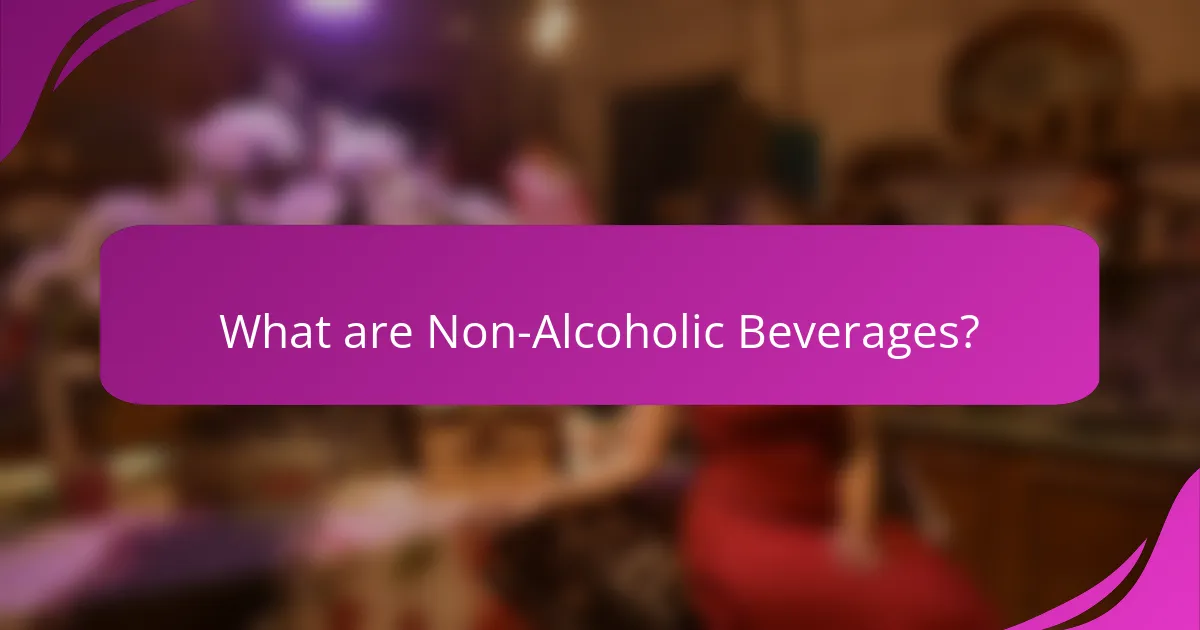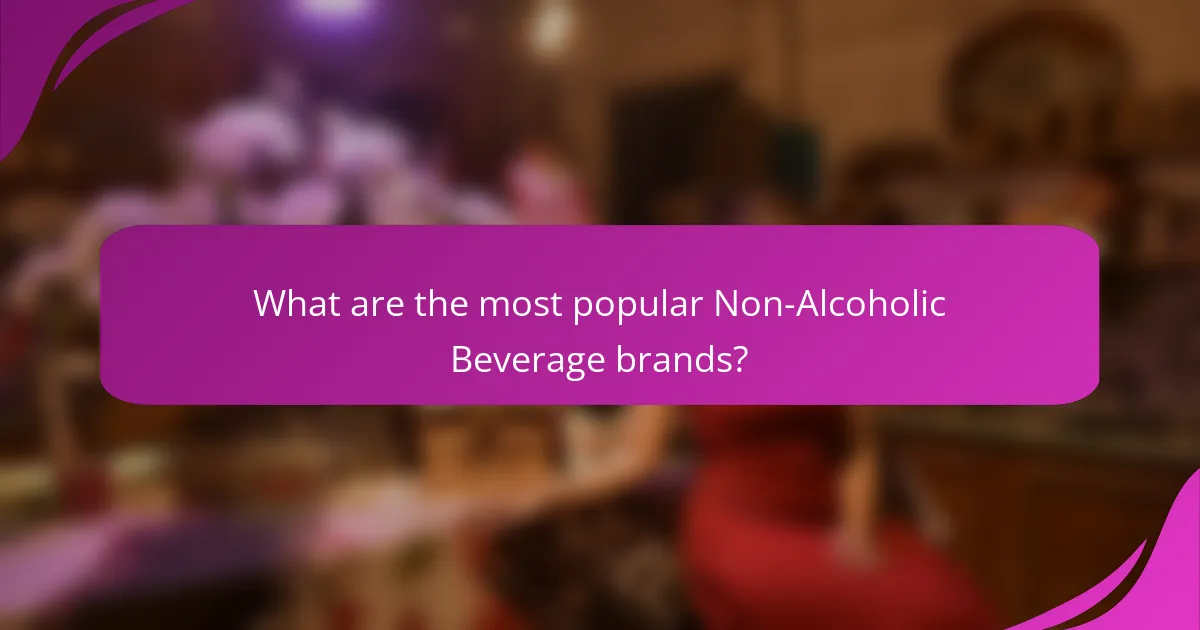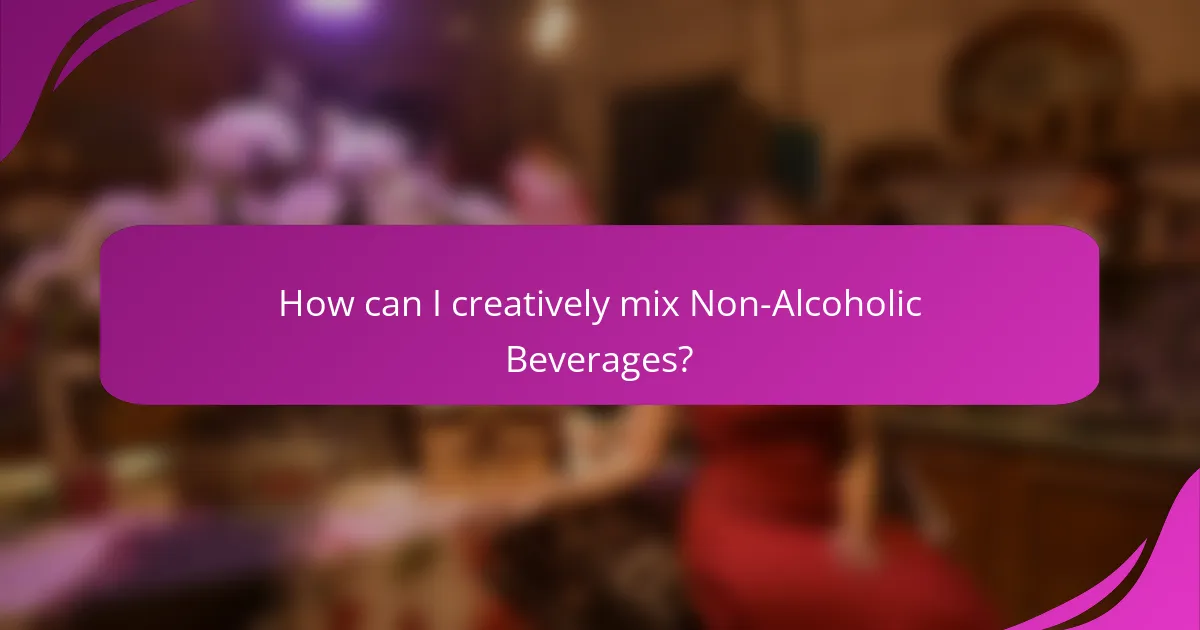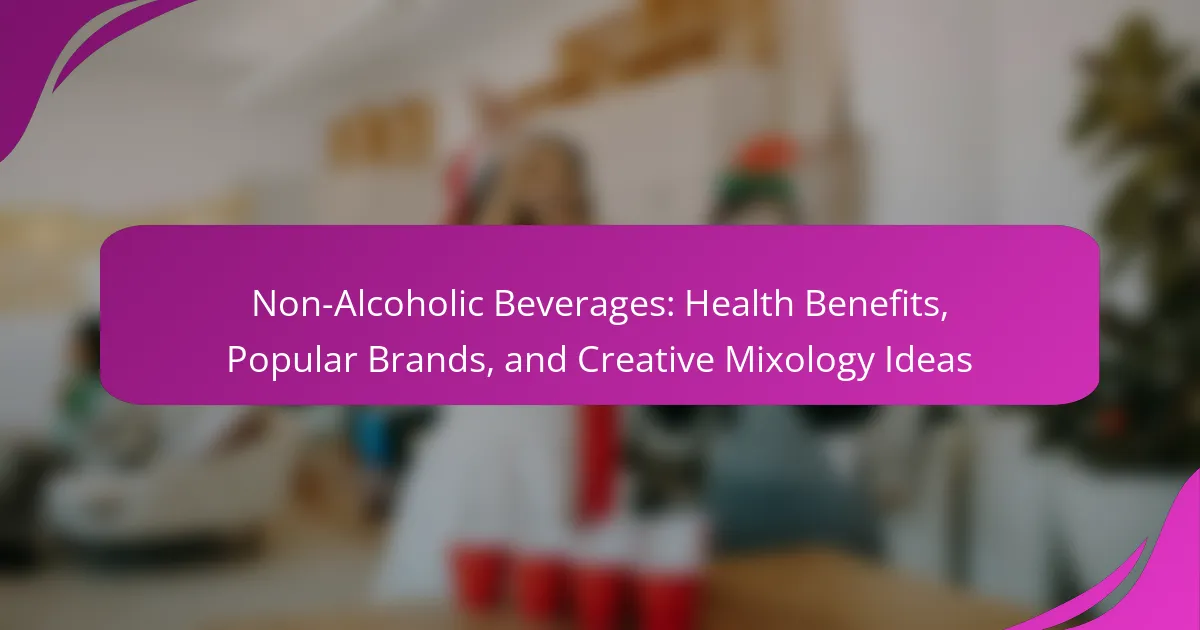Non-alcoholic beverages are drinks that do not contain alcohol and encompass a wide range of options, including soft drinks, juices, and flavored waters. These beverages cater to individuals who choose to avoid alcohol for various reasons, such as health or personal preferences. The article explores the health benefits of non-alcoholic beverages, highlights popular brands like Coca-Cola, Pepsi, and Sprite, and provides creative mixology ideas for crafting unique drinks. Additionally, it emphasizes the accessibility of these beverages in restaurants, bars, and grocery stores, showcasing their increasing popularity and versatility.

What are Non-Alcoholic Beverages?
Non-alcoholic beverages are drinks that do not contain alcohol. They include a variety of options such as soft drinks, juices, and flavored waters. These beverages are designed for individuals who prefer not to consume alcohol for health, personal, or religious reasons. According to the World Health Organization, non-alcoholic beverages can provide hydration and enjoyment without the effects of alcohol. Popular examples include sodas, herbal teas, and non-alcoholic versions of beer and wine. These drinks are widely available and can be found in restaurants, bars, and grocery stores.
How are Non-Alcoholic Beverages classified?
Non-alcoholic beverages are classified mainly into three categories: soft drinks, juices, and non-alcoholic beers. Soft drinks include carbonated beverages that are sweetened and flavored. Juices consist of liquid extracted from fruits or vegetables, often consumed for their nutritional benefits. Non-alcoholic beers are brewed to contain minimal or no alcohol, providing a similar taste to traditional beers. These classifications help consumers identify options based on preference and dietary needs. The global non-alcoholic beverage market was valued at approximately $1.6 trillion in 2020, indicating significant consumer interest in these products.
What types of Non-Alcoholic Beverages are available?
Non-alcoholic beverages include a variety of types. Common categories are soft drinks, juices, teas, and coffees. Soft drinks are carbonated beverages often sweetened with sugar or artificial sweeteners. Juices are extracted from fruits or vegetables and can be 100% pure or blended. Teas can be herbal, black, green, or iced, offering diverse flavors and health benefits. Coffees can be brewed, instant, or cold-brewed, and are often enjoyed without alcohol. Other types include flavored water and non-alcoholic beers and spirits. These beverages cater to various tastes and dietary preferences.
What are the key characteristics of each type?
The key characteristics of non-alcoholic beverages include various types such as juices, sodas, teas, and flavored waters. Juices are typically rich in vitamins and antioxidants. They are often made from fresh fruits or vegetables. Sodas are carbonated and can be sweetened or unsweetened. They usually contain caffeine or flavoring agents. Teas can be herbal, green, or black, providing hydration and health benefits like improved digestion. Flavored waters are often infused with fruits or herbs, offering a refreshing alternative with minimal calories. Each type serves different consumer preferences and health goals.
Why are Non-Alcoholic Beverages gaining popularity?
Non-alcoholic beverages are gaining popularity due to increasing health consciousness among consumers. Many people are seeking healthier lifestyle choices. This shift is reflected in the rising demand for drinks that offer flavor without alcohol’s effects. Health surveys indicate that a significant portion of the population is reducing alcohol intake. For instance, a report by IWSR Drinks Market Analysis noted a 20% growth in the non-alcoholic segment from 2019 to 2021. Additionally, social trends show a preference for inclusivity in social settings, where non-alcoholic options provide alternatives for non-drinkers. The market is responding with innovative products that appeal to diverse taste preferences.
What cultural shifts are influencing this trend?
Increased health consciousness is a significant cultural shift influencing the trend of non-alcoholic beverages. Consumers are prioritizing wellness and seeking alternatives to alcohol. This shift is reflected in the rise of mindful drinking movements. These movements promote moderation and the enjoyment of non-alcoholic options. Additionally, younger generations are embracing sobriety and reducing alcohol consumption. Research indicates that 66% of millennials prefer non-alcoholic drinks for health reasons. Social media platforms amplify this trend by showcasing creative non-alcoholic cocktails. As a result, brands are innovating to meet the demand for flavorful, alcohol-free beverages.
How do health considerations impact consumer choices?
Health considerations significantly influence consumer choices in the non-alcoholic beverage market. Consumers increasingly seek drinks that offer health benefits, such as low sugar content and added vitamins. Research indicates that 66% of consumers consider health claims when purchasing beverages. Additionally, the trend towards functional drinks, which provide health advantages like hydration or immunity support, is rising. Brands that emphasize natural ingredients and transparency in sourcing tend to attract health-conscious buyers. This shift reflects a broader societal trend towards wellness and preventive health measures.
What health benefits do Non-Alcoholic Beverages offer?
Non-alcoholic beverages offer several health benefits. They provide hydration without the negative effects of alcohol. Many non-alcoholic options are low in calories, aiding in weight management. Some beverages, like herbal teas, contain antioxidants that combat oxidative stress. Others, such as certain juices, provide essential vitamins and minerals. For instance, 100% fruit juices can be rich in vitamin C. Additionally, non-alcoholic beers may support heart health due to their polyphenol content. These benefits make non-alcoholic beverages a healthier choice for many individuals.
How do they contribute to hydration and wellness?
Non-alcoholic beverages contribute to hydration and wellness by providing essential fluids to the body. They help maintain optimal hydration levels, which is crucial for bodily functions. For example, water, herbal teas, and infused drinks can replace lost fluids. Staying well-hydrated supports digestion, circulation, and temperature regulation. Additionally, many non-alcoholic beverages contain vitamins and minerals that enhance overall health. For instance, coconut water is rich in electrolytes. This makes it an excellent choice for hydration. Studies indicate that proper hydration can improve cognitive function and mood. Therefore, incorporating non-alcoholic beverages into daily routines aids in maintaining hydration and promoting wellness.
What specific nutrients can be found in these beverages?
Non-alcoholic beverages can contain a variety of specific nutrients. Common nutrients include vitamins, minerals, and antioxidants. For example, fruit juices often provide vitamin C and potassium. Herbal teas may offer antioxidants like flavonoids. Coconut water is known for its electrolytes, including potassium and sodium. Many non-alcoholic beverages also contain dietary fiber, particularly those made from whole fruits or grains. Additionally, some drinks are fortified with vitamins and minerals, enhancing their nutritional profile.

What are the most popular Non-Alcoholic Beverage brands?
Coca-Cola, Pepsi, and Sprite are among the most popular non-alcoholic beverage brands. Coca-Cola has a global market presence and is known for its signature cola flavor. Pepsi, a direct competitor, offers a similar cola taste and a variety of flavors. Sprite is recognized for its lemon-lime flavor and is popular in many regions. Other notable brands include Dr Pepper, Fanta, and Mountain Dew. These brands have established a strong consumer base through effective marketing and product diversification. Their popularity is reflected in sales figures and brand recognition worldwide.
Which brands are leading the market?
Coca-Cola, PepsiCo, and Nestlé are leading brands in the non-alcoholic beverages market. Coca-Cola holds a significant market share with its diverse product range. PepsiCo follows closely, offering popular drinks like Gatorade and Tropicana. Nestlé is known for its bottled water brands, such as Perrier and San Pellegrino. According to market analysis from Statista, these brands dominate due to their extensive distribution networks and strong brand recognition. Their innovative marketing strategies also contribute to their leadership in the industry.
What are the unique selling points of these brands?
It is not possible to provide a specific answer regarding the unique selling points of these brands without knowing which brands are being referenced.
How do these brands differentiate themselves from competitors?
Brands in the non-alcoholic beverage sector differentiate themselves through unique flavor profiles, health benefits, and innovative marketing strategies. For example, some brands focus on organic ingredients to attract health-conscious consumers. Others emphasize functional benefits, such as added vitamins or probiotics, to stand out. Unique packaging and branding also play a significant role in consumer recognition. Brands may target specific demographics, such as millennials or fitness enthusiasts, to create a loyal customer base. Additionally, sustainability practices, like eco-friendly packaging, can enhance brand appeal. These differentiation strategies help brands carve out a niche in a competitive market.
What are the consumer preferences regarding Non-Alcoholic Beverages?
Consumers prefer non-alcoholic beverages that offer health benefits, taste variety, and convenience. A survey by the International Beverage Association found that 70% of consumers seek healthier options. Flavored sparkling waters and herbal teas are increasingly popular. Many consumers appreciate beverages with natural ingredients and low sugar content. Additionally, convenience packaging, like ready-to-drink options, influences purchasing decisions. Seasonal flavors and limited-edition releases also attract consumer interest. Brands that emphasize sustainability and ethical sourcing are gaining traction. Overall, the trend reflects a shift towards mindful consumption and wellness-oriented choices.
How do taste and flavor profiles influence purchasing decisions?
Taste and flavor profiles significantly influence purchasing decisions. Consumers often choose products based on their sensory experiences. Positive taste experiences lead to repeat purchases. Flavor profiles can evoke emotional responses and memories. Research indicates that 80% of consumers prioritize taste when selecting beverages. Brands that effectively communicate flavor attributes tend to attract more customers. Unique flavor combinations can differentiate products in a crowded market. Therefore, taste and flavor profiles are critical factors in consumer choice.
What role do packaging and branding play in consumer choices?
Packaging and branding significantly influence consumer choices. Attractive packaging can capture attention and create a positive first impression. Research indicates that 72% of consumers judge products by their packaging. Branding builds recognition and trust, making consumers more likely to choose familiar brands. Effective branding communicates quality and values, which can resonate with target audiences. For example, eco-friendly packaging appeals to environmentally conscious consumers. Additionally, consistent branding across products fosters loyalty, encouraging repeat purchases. Overall, packaging and branding are critical in shaping consumer perceptions and driving purchasing decisions.

How can I creatively mix Non-Alcoholic Beverages?
To creatively mix non-alcoholic beverages, start by combining various flavors and textures. Use juices, sodas, and flavored waters as base ingredients. Mix citrus juices like lemon or lime with sparkling water for a refreshing spritzer. Combine fruit purees with tonic water for a unique twist. Add herbs like mint or basil for an aromatic touch. Experiment with spices like ginger or cinnamon to enhance flavors. Consider layering ingredients to create visually appealing drinks. Garnish with fresh fruits or edible flowers for added flair. These methods can elevate the overall drinking experience.
What are some popular mixology techniques for Non-Alcoholic Beverages?
Popular mixology techniques for non-alcoholic beverages include muddling, shaking, and layering. Muddling involves crushing herbs or fruits to release their flavors. This technique enhances the taste of drinks like mocktails. Shaking combines ingredients with ice to chill and mix them thoroughly. This method creates a refreshing texture in beverages. Layering involves pouring liquids of different densities to create visually appealing drinks. This technique showcases colorful presentations in cocktails. Each technique contributes to the overall flavor and aesthetic of non-alcoholic beverages.
How can I enhance flavors using spices and herbs?
To enhance flavors using spices and herbs, incorporate them into your beverage recipes thoughtfully. Fresh herbs like mint and basil add vibrant notes. Spices such as cinnamon and ginger introduce warmth and depth. Infusing herbs in hot water or blending them into smoothies extracts their essential oils. Dry spices can be added directly to juices or teas for a flavor boost. The right balance is crucial; too much can overpower the drink. Experimenting with combinations can yield unique flavor profiles. For instance, pairing rosemary with lemon creates a refreshing contrast. Using spices and herbs has been shown to elevate taste perception in beverages.
What tools and equipment are essential for mixology?
Essential tools and equipment for mixology include a shaker, jigger, muddler, and strainer. A shaker is used to mix ingredients thoroughly. A jigger measures precise amounts of liquid for consistency. A muddler helps extract flavors from fruits and herbs. A strainer ensures a smooth pour by filtering out solids. Additional tools include a bar spoon for stirring and a citrus juicer for fresh juice. These tools enhance the quality and presentation of drinks. Proper equipment is crucial for creating balanced and flavorful beverages.
What are some unique recipes for Non-Alcoholic cocktails?
Cucumber Mint Cooler combines cucumber juice, mint leaves, lime juice, and soda water. Muddle mint leaves with lime juice, add cucumber juice, and top with soda water.
Spicy Ginger Fizz features ginger beer, lime juice, and jalapeño slices. Mix ginger beer with lime juice, and add jalapeño for a spicy kick.
Tropical Sunrise uses orange juice, pineapple juice, and grenadine. Pour orange juice and pineapple juice over ice, then slowly add grenadine for a layered effect.
Berry Basil Smash includes muddled berries, basil, lemon juice, and tonic water. Muddle berries and basil, add lemon juice, and top with tonic water.
Lavender Lemonade combines lavender syrup, lemon juice, and water. Mix lavender syrup with lemon juice and water for a refreshing drink.
How can I create refreshing summer drinks?
To create refreshing summer drinks, start with a base of chilled water or sparkling water. Add fresh fruits like lemons, limes, or berries for natural sweetness and flavor. Incorporate herbs such as mint or basil for an aromatic touch. For added zest, include a splash of citrus juice or flavored syrups. Mix all ingredients in a pitcher and let them infuse for a few hours in the refrigerator. Serve the drinks over ice for a cool experience. This method not only enhances taste but also provides hydration.
What are some festive options for special occasions?
Festive options for special occasions include sparkling juices, mocktails, and flavored sodas. Sparkling juices offer a bubbly alternative to champagne. They come in various fruit flavors, appealing to different tastes. Mocktails blend juices, herbs, and spices for unique flavors. Popular mocktail recipes include virgin mojitos and piña coladas. Flavored sodas provide a fun, fizzy option for celebrations. They can be served plain or as mixers in creative drinks. These non-alcoholic choices cater to diverse preferences while maintaining a festive atmosphere.
What tips can help me enjoy Non-Alcoholic Beverages more?
To enjoy non-alcoholic beverages more, explore diverse flavors and brands. Experiment with various types like herbal teas, flavored sparkling waters, and non-alcoholic cocktails. Pair beverages with food to enhance their taste. Use fresh ingredients like fruits and herbs to create unique mixes. Chill drinks properly for optimal refreshment. Attend tastings or workshops to discover new options. Engage with online communities for recipe ideas and recommendations. Keep an open mind to different beverage experiences.
Non-alcoholic beverages are drinks that do not contain alcohol, including soft drinks, juices, and flavored waters, catering to individuals who prefer alcohol-free options for various reasons. The article explores the classification, types, and health benefits of these beverages, highlighting their growing popularity due to increased health consciousness and social trends favoring inclusivity. It also covers the leading brands in the market, consumer preferences, and creative mixology techniques for crafting unique non-alcoholic drinks. Additionally, the article provides insights into the specific nutrients found in these beverages and tips for enhancing flavor and enjoyment.
